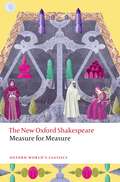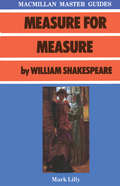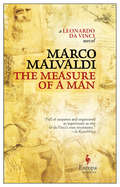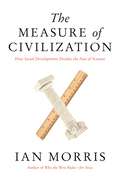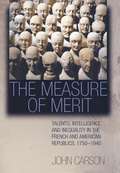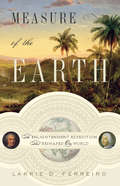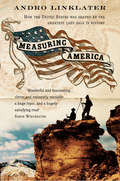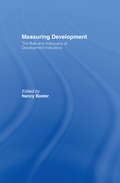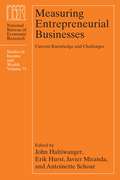- Table View
- List View
Measure for Measure: The New Oxford Shakespeare (Oxford World's Classics)
by William Shakespeare'Some rise by sin, and some by virtue fall.' Can one life be measured against another? Can a woman's body be measured against a man's life? Can consensual sex be measured against rape? Measure for Measure explores these questions through a series of substitutions: Angelo deputises for the Duke, who disguises himself to spy on his subjects; corrupt Angelo demands that almost-nun Isabella gives her body in exchange for her brother's life; and the Duke substitutes living bodies and decapitated heads to bring about a 'happy ending' in this problematic comedy. Exploring corrupt power, state surveillance, and the silencing of women by powerful men, Measure for Measure continues to resonate today. The New Oxford Shakespeare offers authoritative editions of Shakespeare's works with introductory materials designed to encourage new interpretations of the plays and poems. Using the text from the landmark The New Oxford Shakespeare Complete Works: Modern Critical Edition, these volumes offer readers the latest thinking on the authentic texts (collated from all surviving original versions of Shakespeare's work) alongside innovative introductions from leading scholars. The texts are accompanied by a comprehensive set of critical apparatus to give readers the best resources to help understand and enjoy Shakespeare's work. ABOUT THE SERIES: For over 100 years Oxford World's Classics has made available the widest range of literature from around the globe. Each affordable volume reflects Oxford's commitment to scholarship, providing the most accurate text plus a wealth of other valuable features, including expert introductions by leading authorities, helpful notes to clarify the text, up-to-date bibliographies for further study, and much more.
Measure for Measure: The New Oxford Shakespeare (Oxford World's Classics)
by William Shakespeare'Some rise by sin, and some by virtue fall.' Can one life be measured against another? Can a woman's body be measured against a man's life? Can consensual sex be measured against rape? Measure for Measure explores these questions through a series of substitutions: Angelo deputises for the Duke, who disguises himself to spy on his subjects; corrupt Angelo demands that almost-nun Isabella gives her body in exchange for her brother's life; and the Duke substitutes living bodies and decapitated heads to bring about a 'happy ending' in this problematic comedy. Exploring corrupt power, state surveillance, and the silencing of women by powerful men, Measure for Measure continues to resonate today. The New Oxford Shakespeare offers authoritative editions of Shakespeare's works with introductory materials designed to encourage new interpretations of the plays and poems. Using the text from the landmark The New Oxford Shakespeare Complete Works: Modern Critical Edition, these volumes offer readers the latest thinking on the authentic texts (collated from all surviving original versions of Shakespeare's work) alongside innovative introductions from leading scholars. The texts are accompanied by a comprehensive set of critical apparatus to give readers the best resources to help understand and enjoy Shakespeare's work. ABOUT THE SERIES: For over 100 years Oxford World's Classics has made available the widest range of literature from around the globe. Each affordable volume reflects Oxford's commitment to scholarship, providing the most accurate text plus a wealth of other valuable features, including expert introductions by leading authorities, helpful notes to clarify the text, up-to-date bibliographies for further study, and much more.
The Measure of a Man: A Novel about Leonardo da Vinci
by Marco MalvaldiOctober 1493, the height of the Renaissance. In a rapidly changing world, Milan flourishes under the leadership of Ludovico il Moro. Those wandering the courtyards of the city’s castle often encounter a man in his forties dressed in long pink robes, lost in his own thoughts. The man lives above his workshop, with his mother and a mischievous little boy whom he dotes on; he doesn’t eat meat, writes from right to left, and struggles to get paid by his employers. His name is Leonardo da Vinci. His fame extends beyond the Alps, to the French court of Charles VIII, whose envoys have been tasked with a secret mission that concerns Leonardo himself, and his most daring designs. When a man is found dead in the Castle’s courtyard, il Moro turns to Da Vinci for help. Though the corpse shows no signs of violence, the death is highly suspicious: rumours of a plague or superstitious explanations need to be disproven quickly. Leonardo is in no position to refuse his master’s request to investigate.
The Measure of Civilization: How Social Development Decides the Fate of Nations
by Ian MorrisIn the last thirty years, there have been fierce debates over how civilizations develop and why the West became so powerful. The Measure of Civilization presents a brand-new way of investigating these questions and provides new tools for assessing the long-term growth of societies. Using a groundbreaking numerical index of social development that compares societies in different times and places, award-winning author Ian Morris sets forth a sweeping examination of Eastern and Western development across 15,000 years since the end of the last ice age. He offers surprising conclusions about when and why the West came to dominate the world and fresh perspectives for thinking about the twenty-first century. Adapting the United Nations' approach for measuring human development, Morris's index breaks social development into four traits--energy capture per capita, organization, information technology, and war-making capacity--and he uses archaeological, historical, and current government data to quantify patterns. Morris reveals that for 90 percent of the time since the last ice age, the world's most advanced region has been at the western end of Eurasia, but contrary to what many historians once believed, there were roughly 1,200 years--from about 550 to 1750 CE--when an East Asian region was more advanced. Only in the late eighteenth century CE, when northwest Europeans tapped into the energy trapped in fossil fuels, did the West leap ahead. Resolving some of the biggest debates in global history, The Measure of Civilization puts forth innovative tools for determining past, present, and future economic and social trends.
The Measure of Civilization: How Social Development Decides the Fate of Nations
by Ian MorrisIn the last thirty years, there have been fierce debates over how civilizations develop and why the West became so powerful. The Measure of Civilization presents a brand-new way of investigating these questions and provides new tools for assessing the long-term growth of societies. Using a groundbreaking numerical index of social development that compares societies in different times and places, award-winning author Ian Morris sets forth a sweeping examination of Eastern and Western development across 15,000 years since the end of the last ice age. He offers surprising conclusions about when and why the West came to dominate the world and fresh perspectives for thinking about the twenty-first century. Adapting the United Nations' approach for measuring human development, Morris's index breaks social development into four traits--energy capture per capita, organization, information technology, and war-making capacity--and he uses archaeological, historical, and current government data to quantify patterns. Morris reveals that for 90 percent of the time since the last ice age, the world's most advanced region has been at the western end of Eurasia, but contrary to what many historians once believed, there were roughly 1,200 years--from about 550 to 1750 CE--when an East Asian region was more advanced. Only in the late eighteenth century CE, when northwest Europeans tapped into the energy trapped in fossil fuels, did the West leap ahead. Resolving some of the biggest debates in global history, The Measure of Civilization puts forth innovative tools for determining past, present, and future economic and social trends.
The Measure Of Days: The Morland Dynasty, Book 30 (Morland Dynasty #30)
by Cynthia Harrod-Eagles1916. England is at war, and the Morland family is in the thick of it, with two men already in France and three more soon to go. Tragedy strikes Morland Place when Jessie's husband Ned is reported missing on the Western Front. His father launches a desperate bid to find him, but the family fear the worst. Jessie, in mourning and frustrated by her job as an auxiliary nurse, goes to London to work in a military hospital. There she is reunited with her old friend Oliver, posted to the capital under the RAMC. Also in London is Violet, whose affair with the brilliant artist Octavian Laidislaw is about to erupt in scandal . . .The Measure of Days paints a portrait of a family, and a nation, at war, at a pivotal point in history. With the onset of conscription, no one is left unaffected. Every man must hold himself in readiness; and every woman knows that when she says goodbye, it might be for the last time.
The Measure of Merit: Talents, Intelligence, and Inequality in the French and American Republics, 1750-1940
by John CarsonHow have modern democracies squared their commitment to equality with their fear that disparities in talent and intelligence might be natural, persistent, and consequential? In this wide-ranging account of American and French understandings of merit, talent, and intelligence over the past two centuries, John Carson tells the fascinating story of how two nations wrestled scientifically with human inequalities and their social and political implications. Surveying a broad array of political tracts, philosophical treatises, scientific works, and journalistic writings, Carson chronicles the gradual embrace of the IQ version of intelligence in the United States, while in France, the birthplace of the modern intelligence test, expert judgment was consistently prized above such quantitative measures. He also reveals the crucial role that determinations of, and contests over, merit have played in both societies--they have helped to organize educational systems, justify racial hierarchies, classify army recruits, and direct individuals onto particular educational and career paths. A contribution to both the history of science and intellectual history, The Measure of Merit illuminates the shadow languages of inequality that have haunted the American and French republics since their inceptions.
The Measure of Merit: Talents, Intelligence, and Inequality in the French and American Republics, 1750-1940 (PDF)
by John CarsonHow have modern democracies squared their commitment to equality with their fear that disparities in talent and intelligence might be natural, persistent, and consequential? In this wide-ranging account of American and French understandings of merit, talent, and intelligence over the past two centuries, John Carson tells the fascinating story of how two nations wrestled scientifically with human inequalities and their social and political implications. Surveying a broad array of political tracts, philosophical treatises, scientific works, and journalistic writings, Carson chronicles the gradual embrace of the IQ version of intelligence in the United States, while in France, the birthplace of the modern intelligence test, expert judgment was consistently prized above such quantitative measures. He also reveals the crucial role that determinations of, and contests over, merit have played in both societies--they have helped to organize educational systems, justify racial hierarchies, classify army recruits, and direct individuals onto particular educational and career paths. A contribution to both the history of science and intellectual history, The Measure of Merit illuminates the shadow languages of inequality that have haunted the American and French republics since their inceptions.
Measure of the Earth: The Enlightenment Expedition That Reshaped Our World
by Larrie D. FerreiroIn the early eighteenth century, at the peak of the Enlightenment, an unlikely team of European scientists and naval officers set out on the world&’s first international, cooperative scientific expedition. Intent on making precise astronomical measurements at the Equator, they were poised to resolve one of mankind&’s oldest mysteries: the true shape of the Earth. In Measure of the Earth, award-winning science writer Larrie D. Ferreiro tells the full story of the Geodesic Mission to the Equator for the very first time. It was an age when Europe was torn between two competing conceptions of the world: the followers of René Descartes argued that the Earth was elongated at the poles, even as Isaac Newton contended that it was flattened. A nation that could accurately determine the planet&’s shape could securely navigate its oceans, giving it great military and imperial advantages. Recognizing this, France and Spain organized a joint expedition to colonial Peru, Spain&’s wealthiest kingdom. Armed with the most advanced surveying and astronomical equipment, they would measure a degree of latitude at the Equator, which when compared with other measurements would reveal the shape of the world. But what seemed to be a straightforward scientific exercise was almost immediately marred by a series of unforeseen catastrophes, as the voyagers found their mission threatened by treacherous terrain, a deeply suspicious populace, and their own hubris.A thrilling tale of adventure, political history, and scientific discovery, Measure of the Earth recounts the greatest scientific expedition of the Enlightenment through the eyes of the men who completed it—pioneers who overcame tremendous adversity to traverse the towering Andes Mountains in order to discern the Earth&’s shape. In the process they also opened the eyes of Europe to the richness of South America and paved the way for scientific cooperation on a global scale.
A Measured Life: The Times and Places of an Orphaned Intellectual
by Richard HoggartRichard Hoggart's book, The Uses of Literacy, established his reputation as a uniquely sensitive and observant chronicler of English working-class life. This pioneering work, first published in 1957, examines changes in the life and values of the English working class in response to mass media. It maps out a new methodology in cultural studies based around interdisciplinary and a concern with how textsin this case, mass publicationsare stitched into the patterns of lived experience. Mixing personal memoir with social history and cultural critique. The Uses of Literacy anticipates recent interest in modes of cultural analysts that refuse to hide the author behind the mask of objective social scientific technique. In its method and in its rich accumulation of the detail of working-class life, this volume remains useful and absorbing.
A Measured Life: The Times and Places of an Orphaned Intellectual
by Richard HoggartRichard Hoggart's book, The Uses of Literacy, established his reputation as a uniquely sensitive and observant chronicler of English working-class life. This pioneering work, first published in 1957, examines changes in the life and values of the English working class in response to mass media. It maps out a new methodology in cultural studies based around interdisciplinary and a concern with how textsin this case, mass publicationsare stitched into the patterns of lived experience. Mixing personal memoir with social history and cultural critique. The Uses of Literacy anticipates recent interest in modes of cultural analysts that refuse to hide the author behind the mask of objective social scientific technique. In its method and in its rich accumulation of the detail of working-class life, this volume remains useful and absorbing.
Measurement, Realism and Objectivity: Essays on Measurement in the Social and Physical Sciences (Studies in History and Philosophy of Science #5)
by John ForgeThe institutionalization of History and Philosophy of Science as a distinct field of scholarly endeavour began comparatively earl- though not always under that name - in the Australasian region. An initial lecturing appointment was made at the University of Melbourne immediately after the Second World War, in 1946, and other appoint ments followed as the subject underwent an expansion during the 1950s and 1960s similar to that which took place in other parts of the world. Today there are major Departments at the University of Melbourne, the University of New South Wales and the University of Wollongong, and smaller groups active in many other parts of Australia and in New Zealand. "Australasian Studies in History and Philosophy of Science" aims to provide a distinctive publication outlet for Australian and New Zealand scholars working in the general area of history, philosophy and social studies of science. Each volume comprises a group of essays on a connected theme, edited by an Australian or a New Zealander with special expertise in that particular area. Papers address general issues, however, rather than local ones; parochial topics are avoided. Further more, though in each volume a majority of the contributors is from Australia or New Zealand, contributions from elsewhere are by no means ruled out. Quite the reverse, in fact - they are actively encour aged wherever appropriate to the balance of the volume in question.
Measures of Maturity: My Early Life
by N. S. PatolichevMeasures of Maturity: My Early Life focuses on the life journey of N.S. Patolichev, including his experiences in childhood and involvement in the labor sector and the military. The book first highlights the accomplishments of the father of N.S. Patolichev during the Civil War. The text then offers information on the childhood of Patolichev, taking into consideration the harsh realities of poor peasant life that straddled his family. Patolichev particularly highlights the role of horses in alleviating the standard of living of people in his village during that time. The manuscript describes the life of Patolichev when he worked at a chemical plant. He said that working at the plant gave him and his companions their first essential experience in life. Patolichev narrates his experience when he was asked to take the position of Central Committee assistant. The text also underscores his feats during the war, taking into consideration the setbacks that the war brought to nations. Patolichev also describes his experience when he was appointed first secretary of the Chelyabinsk Regional and City Party Committee. The book is a fine reference for readers and war enthusiasts interested in life of N.S. Patolichev.
Measuring America: How The United States Was Shaped By The Greatest Land Sale In History
by Andro LinklaterThis edition contains a limited number of illustrations. Due to the level of detail, maps are best viewed on a tablet.
Measuring Development: the Role and Adequacy of Development Indicators
by Nancy BasterFirst published in 1972. Routledge is an imprint of Taylor & Francis, an informa company.
Measuring Development: the Role and Adequacy of Development Indicators
by Nancy BasterFirst published in 1972. Routledge is an imprint of Taylor & Francis, an informa company.
Measuring Difference, Numbering Normal: Setting The Standards For Disability In The Interwar Period (Disability History Ser.)
by Coreen McGuireMeasuring Entrepreneurial Businesses: Current Knowledge and Challenges (National Bureau of Economic Research Studies in Income and Wealth #75)
by John C. Haltiwanger Erik Hurst Javier Miranda Antoinette SchoarStart-ups and other entrepreneurial ventures make a significant contribution to the US economy, particularly in the tech sector, where they comprise some of the largest and most influential companies. Yet for every high-profile, high-growth company like Apple, Facebook, Microsoft, and Google, many more fail. This enormous heterogeneity poses conceptual and measurement challenges for economists concerned with understanding their precise impact on economic growth. Measuring Entrepreneurial Businesses brings together economists and data analysts to discuss the most recent research covering three broad themes. The first chapters isolate high- and low-performing entrepreneurial ventures and analyze their roles in creating jobs and driving innovation and productivity. The next chapters turn the focus on specific challenges entrepreneurs face and how they have varied over time, including over business cycles. The final chapters explore core measurement issues, with a focus on new data projects under development that may improve our understanding of this dynamic part of the economy.
Measuring Entrepreneurial Businesses: Current Knowledge and Challenges (National Bureau of Economic Research Studies in Income and Wealth #75)
by John Haltiwanger Erik Hurst Javier Miranda Antoinette SchoarStart-ups and other entrepreneurial ventures make a significant contribution to the US economy, particularly in the tech sector, where they comprise some of the largest and most influential companies. Yet for every high-profile, high-growth company like Apple, Facebook, Microsoft, and Google, many more fail. This enormous heterogeneity poses conceptual and measurement challenges for economists concerned with understanding their precise impact on economic growth. Measuring Entrepreneurial Businesses brings together economists and data analysts to discuss the most recent research covering three broad themes. The first chapters isolate high- and low-performing entrepreneurial ventures and analyze their roles in creating jobs and driving innovation and productivity. The next chapters turn the focus on specific challenges entrepreneurs face and how they have varied over time, including over business cycles. The final chapters explore core measurement issues, with a focus on new data projects under development that may improve our understanding of this dynamic part of the economy.
Measuring Entrepreneurial Businesses: Current Knowledge and Challenges (National Bureau of Economic Research Studies in Income and Wealth #75)
by John Haltiwanger, Erik Hurst, Javier Miranda, and Antoinette SchoarStart-ups and other entrepreneurial ventures make a significant contribution to the US economy, particularly in the tech sector, where they comprise some of the largest and most influential companies. Yet for every high-profile, high-growth company like Apple, Facebook, Microsoft, and Google, many more fail. This enormous heterogeneity poses conceptual and measurement challenges for economists concerned with understanding their precise impact on economic growth. Measuring Entrepreneurial Businesses brings together economists and data analysts to discuss the most recent research covering three broad themes. The first chapters isolate high- and low-performing entrepreneurial ventures and analyze their roles in creating jobs and driving innovation and productivity. The next chapters turn the focus on specific challenges entrepreneurs face and how they have varied over time, including over business cycles. The final chapters explore core measurement issues, with a focus on new data projects under development that may improve our understanding of this dynamic part of the economy.
Measuring Entrepreneurial Businesses: Current Knowledge and Challenges (National Bureau of Economic Research Studies in Income and Wealth #75)
by John Haltiwanger, Erik Hurst, Javier Miranda, and Antoinette SchoarStart-ups and other entrepreneurial ventures make a significant contribution to the US economy, particularly in the tech sector, where they comprise some of the largest and most influential companies. Yet for every high-profile, high-growth company like Apple, Facebook, Microsoft, and Google, many more fail. This enormous heterogeneity poses conceptual and measurement challenges for economists concerned with understanding their precise impact on economic growth. Measuring Entrepreneurial Businesses brings together economists and data analysts to discuss the most recent research covering three broad themes. The first chapters isolate high- and low-performing entrepreneurial ventures and analyze their roles in creating jobs and driving innovation and productivity. The next chapters turn the focus on specific challenges entrepreneurs face and how they have varied over time, including over business cycles. The final chapters explore core measurement issues, with a focus on new data projects under development that may improve our understanding of this dynamic part of the economy.
Measuring Human Rights
by Todd Landman Edzia CarvalhoThe measurement of human rights has long been debated within the various academic disciplines that focus on human rights, as well as within the larger international community of practitioners working in the field of human rights. Written by leading experts in the field, this is the most up-to-date and comprehensive book on how to measure human rights. Measuring Human Rights: draws explicitly on the international law of human rights to derive the content of human rights that ought to be measured contains a comprehensive methodological framework for operationalizing this human rights content into human rights measures includes separate chapters on the methods, strengths and biases of different human rights measures, including events-based, standards-based, survey-based, and socio-economic and administrative statistics covers measures of civil, political, economic, social and cultural rights includes a complete bibliography, as well as sources and locations for data sets useful for the measurement of human rights. This volume offers a significant and timely addition to this important area of work in the field of human rights, and will be of interest to academics and NGOs, INGOs, international governmental organizations, international financial institutions, and national governments themselves.
Measuring Human Rights
by Todd Landman Edzia CarvalhoThe measurement of human rights has long been debated within the various academic disciplines that focus on human rights, as well as within the larger international community of practitioners working in the field of human rights. Written by leading experts in the field, this is the most up-to-date and comprehensive book on how to measure human rights. Measuring Human Rights: draws explicitly on the international law of human rights to derive the content of human rights that ought to be measured contains a comprehensive methodological framework for operationalizing this human rights content into human rights measures includes separate chapters on the methods, strengths and biases of different human rights measures, including events-based, standards-based, survey-based, and socio-economic and administrative statistics covers measures of civil, political, economic, social and cultural rights includes a complete bibliography, as well as sources and locations for data sets useful for the measurement of human rights. This volume offers a significant and timely addition to this important area of work in the field of human rights, and will be of interest to academics and NGOs, INGOs, international governmental organizations, international financial institutions, and national governments themselves.
Measuring International Authority: A Postfunctionalist Theory of Governance, Volume III (Transformations in Governance)
by Liesbet Hooghe Gary Marks Tobias Lenz Jeanine Bezuijen Besir Ceka Svet DerderyanThis is the third of five ambitious volumes theorizing the structure of governance above and below the central state. This book is written for those interested in the character, causes, and consequences of governance within the state. This book sets out a measure of authority for seventy-six international organizations (IOs) from 1950, or the time of their establishment, to 2010 which can allow researchers to test expectations about the character, sources, and consequences of international governance. The international organizations considered are regional (e.g. the EU, Andean Community, NAFTA), cross-regional (e.g. Commonwealth of Nations, the Organization of Islamic Cooperation), and global (e.g. the UN, World Bank, WTO). Firstly, the book introduces carefully constructed estimates for the scope and depth of authority exercised by international governments. The estimates are unique in their comparative scope, their specificity, and time span. Secondly, it describes describe broad trends in IO authority by comparing delegation and pooling, over time, across IOs, and across decision areas. Thirdly, it presents the evidence gathered by the authors to estimate international authority by carefully discussing forty-seven international organizations, and showing how their bodies are composed, what decisions each body makes, and how they make decisions. Transformations in Governance is a major new academic book series from Oxford University Press. It is designed to accommodate the impressive growth of research in comparative politics, international relations, public policy, federalism, environmental and urban studies concerned with the dispersion of authority from central states up to supranational institutions, down to subnational governments, and side-ways to public-private networks. It brings together work that significantly advances our understanding of the organization, causes, and consequences of multilevel and complex governance. The series is selective, containing annually a small number of books of exceptionally high quality by leading and emerging scholars. The series targets mainly single-authored or co-authored work, but it is pluralistic in terms of disciplinary specialization, research design, method, and geographical scope. Case studies as well as comparative studies, historical as well as contemporary studies, and studies with a national, regional, or international focus are all central to its aims. Authors use qualitative, quantitative, formal modeling, or mixed methods. A trade mark of the books is that they combine scholarly rigour with readable prose and an attractive production style. The series is edited by Liesbet Hooghe and Gary Marks of the University of North Carolina, Chapel Hill, and Walter Mattli of the University of Oxford.
